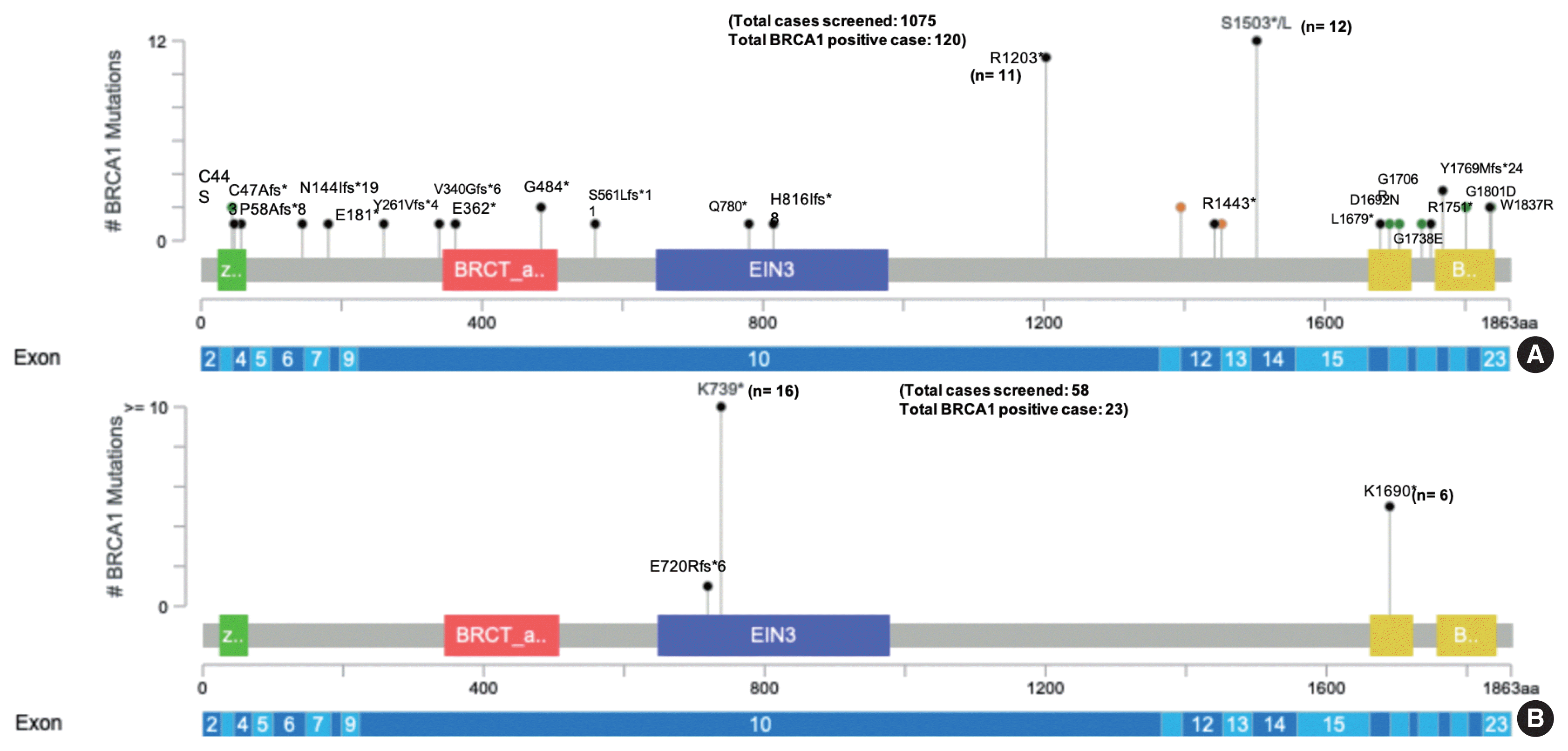1. Kuchenbaecker KB, Hopper JL, Barnes DR, et al. Risks of breast, ovarian, and contralateral breast cancer for BRCA1 and BRCA2 mutation carriers. JAMA. 2017; 317:2402–16.
2. Antoniou A, Pharoah PD, Narod S, et al. Average risks of breast and ovarian cancer associated with BRCA1 or BRCA2 mutations detected in case Series unselected for family history: a combined analysis of 22 studies. Am J Hum Genet. 2003; 72:1117–30.
3. Chen S, Parmigiani G. Meta-analysis of BRCA1 and BRCA2 penetrance. J Clin Oncol. 2007; 25:1329–33.
4. Mehta A.
BRCA1 and BRCA2 mutations in ovarian cancer. J Curr Oncol. 2018; 1:1–4.
5. Tai YC, Domchek S, Parmigiani G, Chen S. Breast cancer risk among male BRCA1 and BRCA2 mutation carriers. J Natl Cancer Inst. 2007; 99:1811–4.
6. Levy-Lahad E, Friedman E. Cancer risks among
BRCA1 and
BRCA2 mutation carriers. Br J Cancer. 2007; 96:11–5.

7. Oh M, Alkhushaym N, Fallatah S, et al. The association of
BRCA1 and
BRCA2 mutations with prostate cancer risk, frequency, and mortality: a meta-analysis. Prostate. 2019; 79:880–95.

8. Nyberg T, Frost D, Barrowdale D, et al. Prostate cancer risks for male
BRCA1 and
BRCA2 mutation carriers: a prospective cohort study. Eur Urol. 2020; 77:24–35.

9. Hu C, Hart SN, Polley EC, et al. Association between inherited germline mutations in cancer predisposition genes and risk of pancreatic cancer. JAMA. 2018; 319:2401–9.

10. Nelson HD, Fu R, Goddard K, et al. Risk assessment, genetic counseling, and genetic testing for BRCA-related cancer: systematic review to update the U.S. Preventive Services Task Force Recommendation. Report AHRQ Publication No. 12-05164-EF-1. Portland: Oregon Health and Science University;2013.
11. Hall MJ, Reid JE, Burbidge LA, et al.
BRCA1 and
BRCA2 mutations in women of different ethnicities undergoing testing for hereditary breast-ovarian cancer. Cancer. 2009; 115:2222–33.

12. Balmana J, Diez O, Rubio IT, Cardoso F; ESMO Guidelines Working Group. BRCA in breast cancer: ESMO clinical practice guidelines. Ann Oncol. 2011; 22(Suppl 6):vi31–4.
13. Rosenthal E, Moyes K, Arnell C, Evans B, Wenstrup RJ. Incidence of
BRCA1 and
BRCA2 non-founder mutations in patients of Ashkenazi Jewish ancestry. Breast Cancer Res Treat. 2015; 149:223–7.

14. Yadava YP. Linguistic diversity in Nepal: perspectives on language policy. In : International Seminar on Constitutionalism and Diversity in Nepal; 2007 Aug 22–24; Kathmandu, Nepal.
15. Daly MB, Pilarski R, Yurgelun MB, et al. NCCN guidelines insights: genetic/familial high-risk assessment: breast, ovarian, and pancreatic, version 1.2020. J Natl Compr Canc Netw. 2020; 18:380–91.
16. Mehta A, Vasudevan S, Sharma SK, et al. Germline BRCA1 and BRCA2 deleterious mutations and variants of unknown clinical significance associated with breast/ovarian cancer: a report from North India. Cancer Manag Res. 2018; 10:6505–16.
17. Lih CJ, Harrington RD, Sims DJ, et al. Analytical validation of the next-generation sequencing assay for a nationwide signal-finding clinical trial: molecular analysis for therapy choice clinical trial. J Mol Diagn. 2017; 19:313–27.
18. Richards S, Aziz N, Bale S, et al. Standards and guidelines for the interpretation of sequence variants: a joint consensus recommendation of the American College of Medical Genetics and Genomics and the Association for Molecular Pathology. Genet Med. 2015; 17:405–24.

19. Gao J, Aksoy BA, Dogrusoz U, et al. Integrative analysis of complex cancer genomics and clinical profiles using the cBioPortal. Sci Signal. 2013; 6:pl1.

20. Cerami E, Gao J, Dogrusoz U, et al. The cBio cancer genomics portal: an open platform for exploring multidimensional cancer genomics data. Cancer Discov. 2012; 2:401–4.

21. Tonin P, Weber B, Offit K, et al. Frequency of recurrent
BRCA1 and
BRCA2 mutations in Ashkenazi Jewish breast cancer families. Nat Med. 1996; 2:1179–83.

22. Kopanos C, Tsiolkas V, Kouris A, et al. VarSome: the human genomic variant search engine. Bioinformatics. 2019; 35:1978–80.

23. Schwarz JM, Cooper DN, Schuelke M, Seelow D. MutationTaster2: mutation prediction for the deep-sequencing age. Nat Methods. 2014; 11:361–2.

24. Fokkema IF, Taschner PE, Schaafsma GC, Celli J, Laros JF, den Dunnen JT. LOVD v.2.0: the next generation in gene variant databases. Hum Mutat. 2011; 32:557–63.

25. Karczewski KJ, Francioli LC, Tiao G, et al. The mutational constraint spectrum quantified from variation in 141,456 humans. Nature. 2020; 581:434–43.

26. Landrum MJ, Lee JM, Benson M, et al. ClinVar: improving access to variant interpretations and supporting evidence. Nucleic Acids Res. 2018; 46:D1062–7.






 PDF
PDF Citation
Citation Print
Print



 XML Download
XML Download